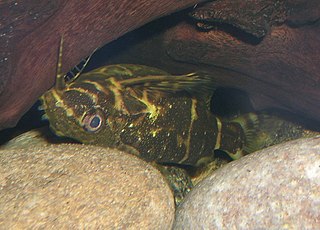
The Mochokidae are a family of catfishes that are known as the squeakers and upside-down catfish. There are nine genera and about 200 species of mochokids. All the mochokids are freshwater species originating from Africa.

Synodontis nigriventris, the blotched upside-down catfish, is a species of upside-down catfish native to the Congo Basin of Cameroon, the Democratic Republic of the Congo and the Republic of the Congo.

The black-bellied slender salamander, Batrachoseps nigriventris, is a small species of salamander that is endemic to California.

The name upside-down catfish is most commonly used by aquarists to refer to the mochokid catfish Synodontis nigriventris alternately known to ichthyologists as the blotched upside-down catfish or false upside-down catfish. However, a number of other fish may also be known by this name:

The black-bellied hummingbird is a species of hummingbird in the family Trochilidae.
Ischnocnema nigriventris is a species of frog in the family Brachycephalidae. It is endemic to the Serra do Mar in eastern São Paulo state, Brazil. Until a population was found in Bertioga in 2006, the species was only known from the brief species description published in 1925 and a single specimen collected in the 1980s.
Tropidophis nigriventis, or the black-bellied dwarf boa, is a species of snake in the family Tropidophiidae. The species is endemic to Cuba.

Onthophagus nigriventris is a species of dung beetle in the family Scarabaeidae.

Forelius nigriventris is a species of ant in the genus Forelius. Described by Forel in 1912, the species is endemic to South America.
Bacchisa nigriventris is a species of beetle in the family Cerambycidae. It was described by Thomson in 1865. It is known from Borneo and Malaysia.
Plaxomicrus nigriventris is a species of beetle in the family Cerambycidae. It was described by Pu in 1991.
Adesmus nigriventris is a species of beetle in the family Cerambycidae. It was described by Fleutiaux and Sallé in 1889. It is known from Guadeloupe.
Oberea nigriventris is a species of beetle in the family Cerambycidae. It was described by Henry Walter Bates in 1873. It is known from Malaysia, Japan, Laos, Vietnam, China, Myanmar, and Taiwan.
Phytoecia nigriventris is a species of beetle in the family Cerambycidae. It was described by Hermann Julius Kolbe in 1893, originally under the genus Blepisanis. It has a wide distribution in Africa.
Anthrax nigriventris is a species of bee flies.
Eugnamptus nigriventris is a species of leaf rolling weevil in the family of beetles known as Attelabidae. It is found in North America.
Criorhina nigriventris is a species of syrphid fly in the family Syrphidae.
Argyra nigriventris is a species of long-legged fly in the family Dolichopodidae.
Proctacanthus nigriventris is a species of robber flies.






